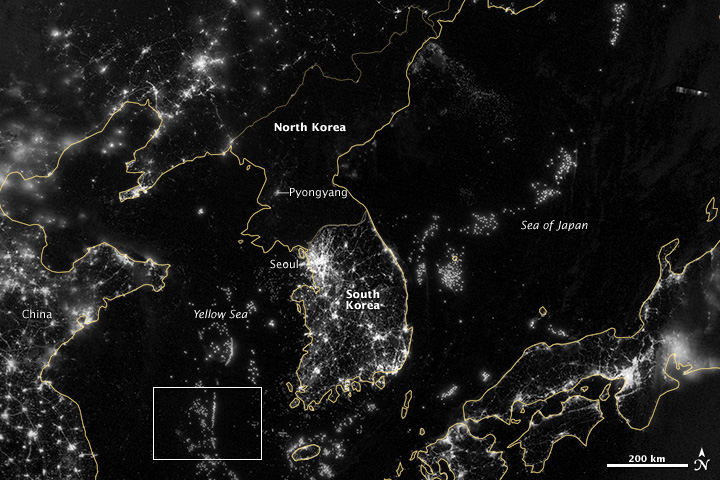
“My life would not have begun as it has and I would not be here today,” said President of South Korea Moon Jae-in at the Marine Corps Museum last month, thanking the United States for saving over 100,000 Korean civilians, including his parents, during the 1950 Battle of Chosin Reservoir.
 Sixty-seven years later, satellite image of the Korean peninsula at night demonstrates a stark contrast of the two Koreas: South Korea, a thriving democracy and bustling economy, with bright lights next to dark North Korea.
Sixty-seven years later, satellite image of the Korean peninsula at night demonstrates a stark contrast of the two Koreas: South Korea, a thriving democracy and bustling economy, with bright lights next to dark North Korea.
American economic investment and humanitarian aid produced considerable dividends by helping to build the foundation for the economic transformation of South Korea, which has since become America’s sixth largest trading partner. U.S. exports to South Korea have tripled since 1990 to $43 billion in 2015, more in one year than all development assistance the U.S. provided to Korea since the war.
As Vice President Mike Pence, whose father served in the Korean War, said, “South Korea is one of the fastest growing sources of foreign direct investment in the United States of America with more than $40 billion and growing invested in the United States so far.” America’s robust economic engagement with South Korea between 2012 and 2016 created more than 2.5 million private-sector jobs in the United States, including tens of thousands of manufacturing jobs.
U.S. foreign assistance not only helped South Korea’s transformation into America’s trading partner— South Korea is now itself a donor of foreign assistance. USAID closed its office in 1980, and since then, South Korea has worked alongside the United States in developing countries to combat poverty and diseases. In Ethiopia, the Korean International Cooperation Agency (KOICA) in partnership with USAID has committed $5 million to directly support the government’s efforts to end child and maternal death.
Congressman Ted Yoho (R-FL), Chairman of the House Congressional Caucus for Effective Foreign Assistance wrote that “South Korea’s example should be one that U.S. development advocates and professionals strive for as they articulate a vision for a modern development agenda.”
South Korea is just one example. America’s strategic investments in diplomacy and development have generated significant return in other parts of the world: 11 of the top 15 U.S. export markets are former recipients of U.S. foreign assistance.
As Bill Gates once said, “the one percent we spend on aid for the poorest not only saves millions of lives, it has an enormous impact on developing economies – which means it has an impact on our economy.”
Images: Seoul, South Korea; North and South Korea from space (NASA).